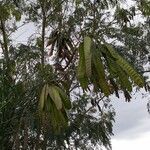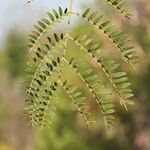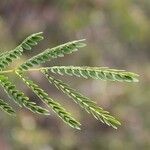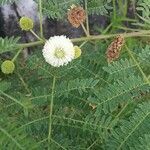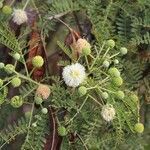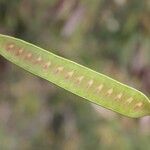Shrub or small tree to c. 10(-15) m high; branchlets terete, at the top densely grey pubescent. Leaves: rachis 15-20 cm, often with an orbicular gland below the junction of the proximal pair of pinna; pinnae 3-10 pairs, 10 cm; leaflets 5-20 pairs per pinna, linear or linear-oblong, 6-21 by 1.5-5 mm, base slightly asymmetrically cuneate, apex acute or short-apiculate; both surfaces glabrous, margins ciliate, lower surface glaucous. Inflorescences consisting of pedunculate glomerules aggregated up to 3 in the leaf-axils or in terminal racemes; peduncles 2-5 cm, densely grey pubescent. Flowers: calyx tubular-campanu-late, c. 2.5 mm, puberulous at the apex, teeth triangular, acute. Petals spathulate 4.5-5 mm, puberulous. Stamens 10, creamy white to greenish white, filaments 8-10 mm. Ovary stipitate, velutinous at the apex. Pods straight, 20 by 2 cm. Seeds 15-30, obliquely held in pod, narrowly ovate, compressed, 6-9 by 3-4.5 mm, obtuse at the apex, cuneate at the base; areole oblong, c. 4 by 1.5 mm, open towards the hilum.
Shrubs or small trees, 2-6 m tall. Branchlets pubescent, glabrous when old, with brown lenticels. Stipules caducous, deltoid, very small; pinnae 4-8 pairs, 5-9(-16) cm, rachis pubescent with black glands at location of lowest pinnae; leaflets 5-15 pairs, linear-oblong, 7-13 × 1.5-3 mm, main vein close to upper margin, base cuneate, margin ciliate, apex acute. Heads usually 1 or 2, axillary, 2-3 cm in diam.; peduncle 2-4 cm; bracts deciduous, pubescent. Flowers white. Calyx ca. 3 mm, outside glabrous at base, puberulent at apex, 5-toothed. Petals narrowly oblanceolate, ca. 5 mm, outside pubescent. Stamens 10, sparsely pubescent, ca. 7 mm. Ovary shortly stipitate, sparsely pubescent; stigma cupular. Legume straight, strap-shaped, flat, 10-18 × 1.4-2 cm, leathery, base attenuate, pedicel to 3 cm, pubescent, beak acute, hard. Seeds 6-25, brown, glossy, narrowly ovoid, flat, 6-9 × 3-4.5 mm. Fl. Apr-Jul, fr. Aug-Oct. 2n = 104*.
Shrub or tree to 4 (–10+) m high. Leaves: axes with oval gland below pinnae pairs; smaller gland at apical pair of leaflets. Pinnae 3–10-jugate with glabrous or appressed-puberulous axes, to 35 cm long; leaflets 5–20-jugate, inequilaterally oblong to oblong-lanceolate, acute, 8–21 mm long, 2–5 mm wide, glabrous or margin ±ciliolate. Inflorescences 1–3 in leaf axils or several arranged in terminal raceme, capitate; peduncles 20–65 mm long, glabrous or appressed-puberulous; heads globular, 10–20 mm diam., whitish, greenish white, cream or pale yellow. Flowers sessile; calyx lobes puberulous or only ciliolate; petals free, glabrous or appressed-puberulous. Pods narrowly oblong to broadly linear, flat, 8–22.5 cm long, 15–27 mm wide, brown when mature, glabrous throughout or only thickened margins puberulous. Seeds flat, oval to obovate, 6–9 mm long, 3–4.5 mm wide, glossy brown.
Unarmed shrub or small tree, up to 4 m high; branchlets densely grey-puberulous. Leaves dark green, often grey-puberulous; glands at junction of lowest pair of pinnae. Pinnae in (2)3-8 opposite pairs. Leaflets 7-20 pairs, 7-15 mm long, obliquely oblong-lanceolate, acute apically. Inflorescences globose heads up to 18 mm in diam., borne singly or in groups of 2 or 3 in leaf axils at branch ends. Flowers white or pale yellow. Anthers hairy, distinguishing it from all other Mimosoideae in sthn Afr. Flowering time July-Mar. Pod brown, 110-180 mm long, ± straight, compressed, in distinctive clusters.
A small erect tree. It grows to 6-10 m high. It has fine divided leaves. The leaves have 2 rows of leaflets. The leaves are 15 to 25 cm long and the leaflets 8 to 16 cm long. They are a dark dull green on top and dull greyish green underneath. The flowers are white and in round heads. They are in the axils of leaves or on the ends of branches. The pods are flat and 10-15 cm long and 1.8 cm wide with 15-25 seeds inside. It has shiny brown seeds. There are 3 subspecies.
Leaves: petiole 2-4·7 cm. long, often with a gland at the junction of the lowest pair of pinnae, glands otherwise absent; rhachis (2·5)7-15 cm. long; pinnae (2)3-8 pairs, opposite; leaflets (5)7-17(21) pairs, 7-18 x 1·5-5 mm., obliquely oblong-lanceolate, acute at the apex, puberulous on the margins and sometimes also on the midrib beneath.
Shrub or small tree 0·6-9 m. high; young branchlets densely grey-puberulous.
Pods 8-18 x (1·4)1·8-2·1 cm., with a stipe up to 3 cm. long.
Petals 4-5·25 mm. long, puberulous above outside.
Stamen-filaments 6·5-7·5 mm. long; anthers hairy.
Calyx 2-3·5 mm. long, puberulous above outside.
Seeds 7·5-9 x 4-5 mm., elliptic to obovate.
Heads of flowers white to cream.
Peduncles 2·5 cm. long.
